Site menu:
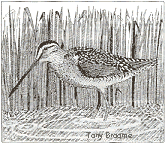
April 2020 Newsletter
Long-billed Dowitcher.
Colour Ring Report.
March Bird News.
Forthcoming Events.
Latest Newsletter.
Species Spotlight - Long-billed Dowitcher
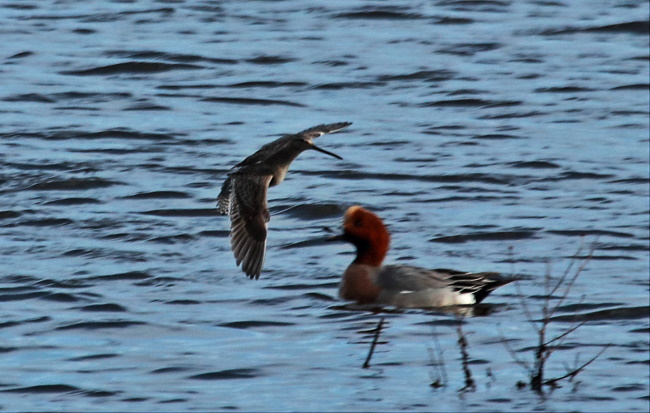
A Long-billed Dowitcher was recorded at Burton Mere
Wetlands RSPB on
February 24th and 25th 2020. Long-billed Dowitchers are BBRC (British
Birds Rarities Committee) rarities, i.e. national rarities, so always
exciting to see and this one gave good views from the Inner Marsh Farm
Hide over the two days. It was an adult, it's relatively short bill and
some rufous on it's face made it fairly distinctive so it's known it
was the same bird that arrived at Marshside RSPB (Southport) in
January where it stayed until early February. It was at nearby Martin
Mere WWT on February 23rd, moved to BMW for two days before returning
to Martin Mere on the 26th. At least one other bird was present in the
country over this period with one in Devon, plus another across the
Irish Sea at Wicklow.
Here are the Dee Estuary records for this species:
1961 November 19th - Dowitcher at
Shotton Lagoons.
1964 June 21st - Dowitcher at
Shotton Lagoons.
Due to identification difficulties
many Dowitcher records were often not specified to species (Long-billed
Dowitcher or Short-billed Dowitcher) until the 1970s. Since the 1970s
identification has been clearer and the UK totals from 1950 (where
species specified) are 258 Long-billed Dowitchers and four Short-billed
Dowitchers. Short-billed Dowitchers have never been recorded on the Dee
Estuary or in the adjacent counties of Cheshire and Clwyd. Therefore it
seems highly likely that the two records in the 1960s were Long-billed
Dowitchers. All the records below were accepted as Long-billed
Dowitchers.
1979 October 14th to 26th - Burton
Marsh.
1993 October 24th to November 3rd -
Inner Marsh Farm (juvenile).
2002 November 10th - Inner Marsh Farm.
2003 January 28th to April 27th -
Inner Marsh Farm (first winter).
2005 October 12th to November 7th -
Inner Marsh Farm (juvenile).
2009 September 26th to October 17th -
Inner Marsh Farm (two juveniles),
October 19th to 21st - Connah's Quay Nature Reserve (one juvenile),
October 28th to 31st - Inner Marsh Farm (one juvenile).
2010 February 14th to 18th - Burton
Marsh (adult), August 26th - Inner
Marsh Farm (adult), August 28th to October 11th - Connah's Quay Nature
Reserve (adult).
2012 October 1st to 19th - Burton Mere
Wetlands (juvenile).
2020 February 24th and 25th - Burton
Mere Wetlands (adult).
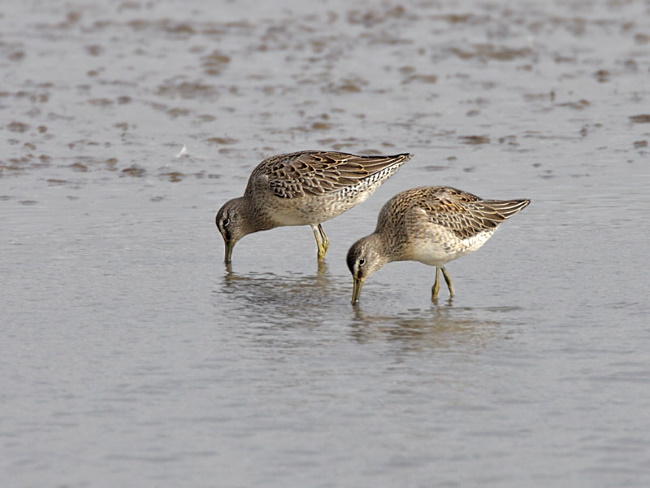
The majority of 'new' birds into the UK are
juveniles and there is a noticeable peak of records in September and
October as you would expect, and as is normal for Neartic waders. Some
do then stay for a considerable time and there are
records of these birds in the UK throughout the year. It is very likely
the adult seen on the Dee Estuary in 2010 was one of the juveniles
recorded in 2009.
Like most birders I find migration fascinating and
it is intriguing to speculate by which route these birds arrive in the
UK. They breed on the far side of the northern
hemisphere from this country so they could arrive here either from the
west or from the east.
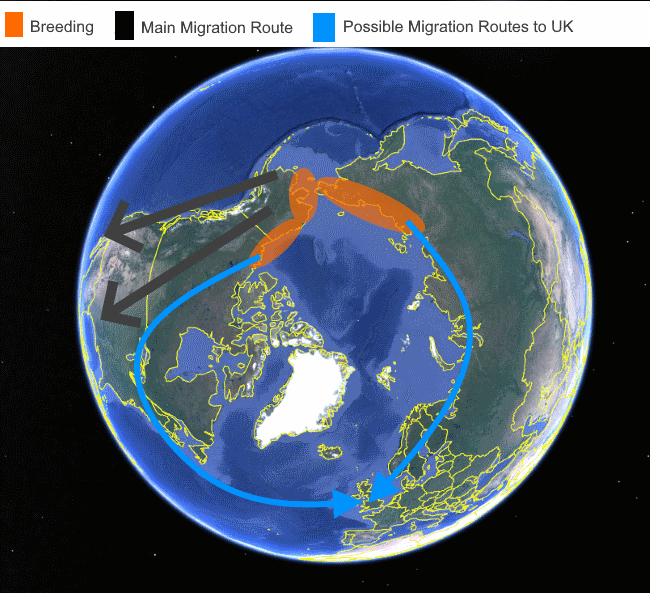
Long-billed Dowitchers breed in northern Alaska and north-east Siberia.
In contrast Short-billed Dowitchers breed right across Canada including
near the east coast, these migrate south along the western Atlantic
flyway and you would therefore think we would see more of these when
they get blown across the Atlantic by weather systems, but they remain
ultra rare. Long-billed Dowitchers migrate south and south-east mainly
west of the Mississippi and therefore are unlikely to get blown across
the Atlantic, at least that is what you would think. However, there is
an argument that there is a strong west to east movement, particularly
from Siberia, and the birds we see are those that over-shoot their
normal flyway and end up in the north Atlantic. Looking at the map it
is conceivable that some just fly straight over the north pole! Or they
could arrive by flying west from eastern Siberia where there has been a
recent range expansion. Holt et al. , in the 2017 Report on Rare Birds
in Great Britain, say this: "It is perhaps unsurprising then that some
are caught up with other Arctic shorebirds moving west in autumn to
arrive on the east coast of Britain". You have to say all these routes
seem unlikely yet they continue to arrive here with an average of five
records per year in the UK.
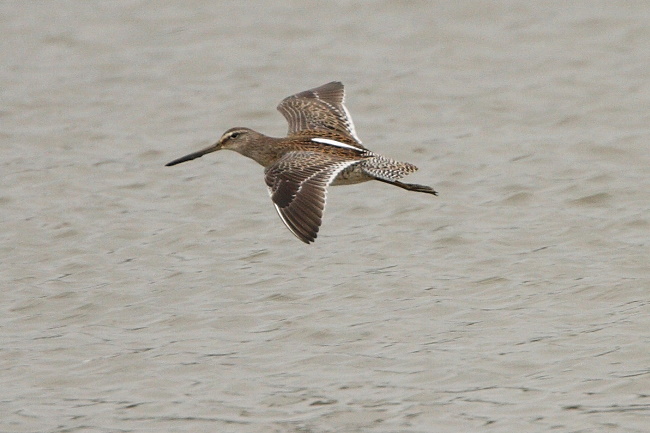
References:
1. Holt et al., Report on rare birds in Great Britain in 2017, British Birds October 2018.
2. BBRC Reports published in British Birds, various.
3. Allan Conlin & Eddie Williams, Rare and Scarce Birds of Cheshire & Wirral, 2017.
4. Robin Sandham, Scarce and Rare Birds in North Wales, 2017.
Richard Smith.
Colour Ring Report
Oystercatcher
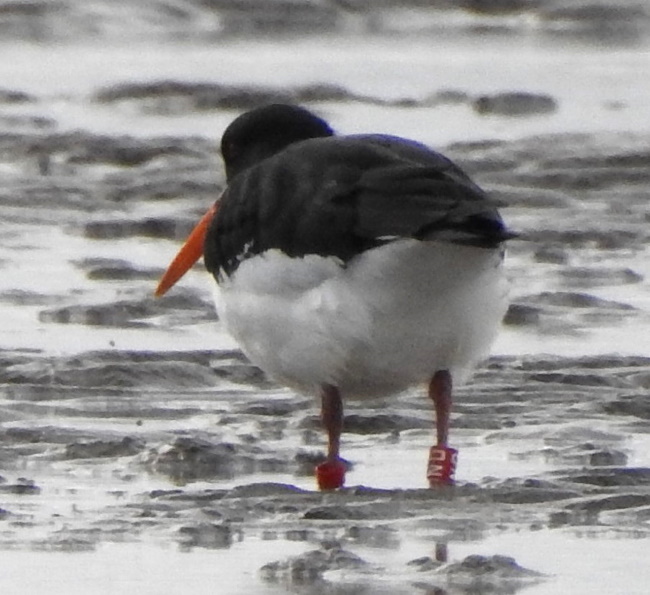
R-NO (Red left tarsus - white NO on red ring, right tarsus).
Ringed at Newtonmore, Highland (Scotland) on March 17th 2018.
Recorded on Thurstaston Shore on January 28th 2020.
Nigel Buxton, the ringer, says: Thanks for this sighting; it is a bird
from our study of local breeding birds at Newtonmore, Highland. We have
been ringing birds here since 1996 and for the last 2 years have been
adding colour rings. Recoveries/controls and colour ring sightings show
that these birds winter all round the Irish sea coasts – Lancashire,
North Wales, Irish Republic, Northern Ireland, SW Scotland and now
Merseyside/Cheshire. The birds are very site faithful and some birds we
have caught 3 & 4 times although N0 was a new bird ringed on
17th March 2018 (FP48151). The location is a night-time roost on
the banks of the River Spey a little way north of Newtonmore
(NN736997). All the birds on it are full adults, with younger birds
still being elsewhere, although at least some do return to their natal
areas when they are older (as other ring controls show).
Mediterranean Gulls
It's always good to see a Mediterranean Gull, so
much more impressive than the slightly smaller Black-headed Gull. Quite
a lot of these are colour-ringed and over the years 16 have been
recorded on the Dee Estuary and North Wirral, and they have all been
ringed on the continent in countries to the east of us - Belgium,
Netherlands, Germany, Denmark, Poland and Slovakia. The two below have
an interesting history, particularly PPJ3.
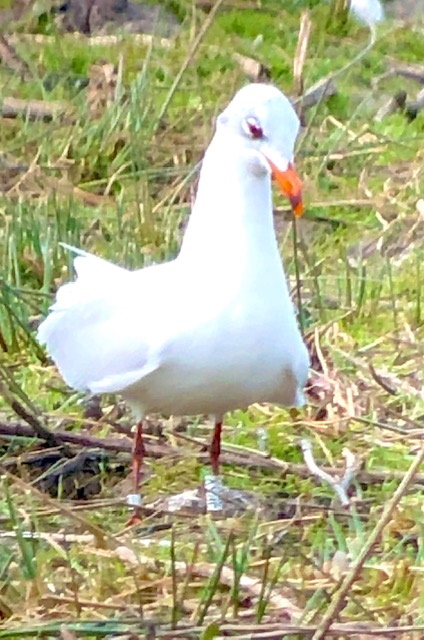
3PKV - on white ring.
Ringed on De Kreupel Island, Ijsselmeer, north Netherlands on June 15th
2018.
Recorded:
Nevern Estuary, Newport, Pembrokeshire in January 2019.
Holyhead, Anglesey, in January 2020.
Burton Mere Wetlands on March 19th 2020.
De Kreupel is a lonely little island right out in
the middle of the extensive Ijsselmeer, it is an artificial island
specially created for wildlife and is full of nesting terns and gulls
through the summer.

PPJ3 -
white on red ring, ringed as a chick.
Ringed in Wojcice in SW Poland on June 4th 2015.
Recorded:
Ameland, Netherlands in July 2015.
Farne Islands in April 2016.
Cedynia, Poland, in May 2017.
Hoylake in September 2017.
Old Moor Wetlands, Yorkshire, in March 2018.
Mecklenburg, NE Germany, in May 2018 and May 2019.
Poznan, Poland, June 2019.
Kerr's Field, Leasowe, on several dates March 2020.
This bird appears to be breeding in north-east Germany but in 2019
moved south-east back to near where it was hatched before moving west
to the UK.
Grey Plover
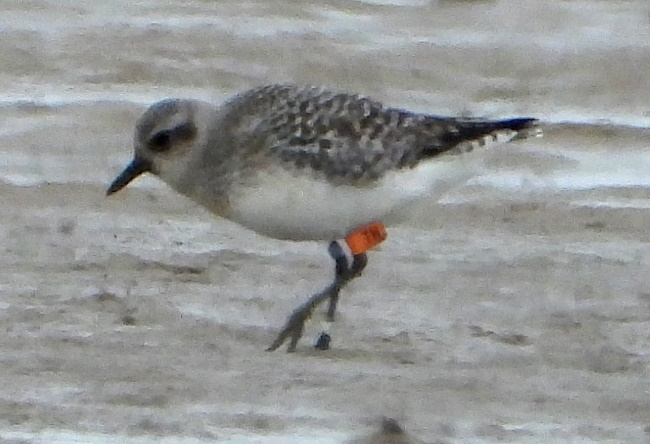
Four Orange flagged Grey Plovers were recorded in
March. They included 'TH' and 'VJ' - these have been recorded three
times since being ringed, and always together.
TH and VJ on Orange
Flag
(left tarsus), Pale blue ring (right tarsus).
Ringed at Altcar on March 22nd 2019.
Recorded:
Formby on April 17th 2019.
Southport on April 24th 2019.
Meols on March 18th 2020.
TC on Orange Flag,
reported in the March Newsletter, was again at West Kirby in March,
almost a month to the day when it was in the exact spot in February.
March Bird News
Covid-19:
People are still seeing interesting
birds either on their daily
exercise or from their homes and gardens so, for the time being, I'll
continue to report these. I hope to keep on producing this newsletter
although I imagine the next two or three may be significantly shorter
than normal, and there certainly won't be any events to publicise. In
the UK we are likely to see a peak in Corvid-19 cases in April, so it
is possible I will not produce a May newsletter. By the summer I hope,
I'm sure we all hope, that restrictions will begin to be lifted.
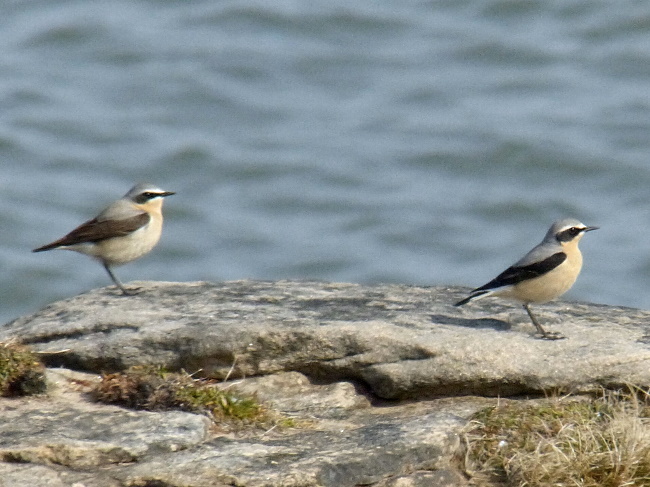
To me the harbinger of Spring is the first Wheatear,
and once these start coming through they just keep coming. The first
one was a bit late this year, and all the early migrants were later
than last year. But February 2019 was more like May with warm weather
so that's not surprising. The table shows the first arrival of some of
the more common spring migrants for this year and 2019 and 2018.
| Species | 2020 | Location | 2019 | 2018 |
|---|---|---|---|---|
| White Wagtail | 1st March | Leasowe Lighthouse |
28th Feb |
14th March |
| Sand Martin | 16th March |
Leasowe Lighthouse |
16th Feb | 15th March |
| Wheatear | 16th March | Leasowe Lighthouse |
27th Feb |
9th March |
| Swallow | 23rd March | Leasowe Lighthouse |
21st March | 29th March |
| Willow Warbler | 26th March | Hoylake
and Heswall |
24th March | 27th March |
| House Martin | 31st March | 6th April | ||
| Whitethroat | |
14th April | 7th April | |
| Cuckoo | |
18th April | 23rd April | |
| Swift | |
|
23rd April | 22nd April |
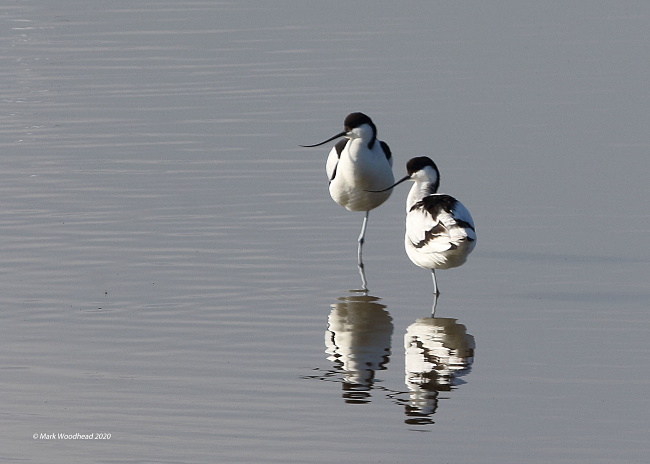
Avocets had built up to an impressive 112 at Burton Mere Wetlands by
the 16th. I don't know how many heron species are attempting to breed
there but we have two Cattle Egrets, two Spoonbills and probably well
over 10 Great Egrets on the estuary, as well as a few hundred Little
Egrets. Four Bearded Tits have been showing well at the reserve. During
the high spring tide of the 12th, when the sea covered the marsh, many
birds flew to BWM and the list of highlights for that day is pretty
impressive: 4,000+ Redshank, 5 Spotted Redshank, 62 Avocet, 220
Black-tailed
Godwit, 40 Golden Plover, 10,000+ Pink-footed Geese, 2 Mediterranean
Gull, 21 Grey Heron, 8 Great Egret, 3 Marsh Harrier and 75 Shoveler.

With several high tides in February inundating the
marshes and presumably wiping out the rodent population I thought our
Short-eared Owls would have moved on, but surprisingly there were still
plenty about with good views in particular at Heswall Golf Course where
they were seen both on the adjacent marsh and on the golf course
itself, max count was five on the 1st. At least four Marsh Harriers and
two Hen Harriers, including a grey male, were recorded regularly
through the month.
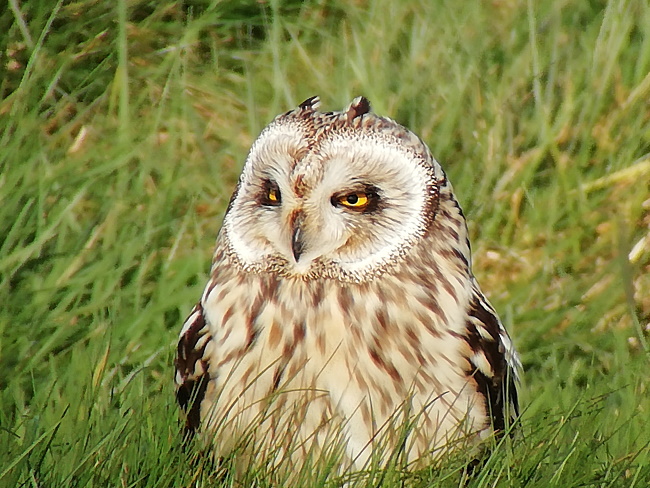
Two drake Eiders were at Hilbre and this one below gave particularly
good views. The first two Gannets of the year were spotted from the
island on the 10th. Four Little Gulls were on passage on the 15th but
numbers have been very low so far, hopefully we will see more in
April. Brent Geese reached a very creditable 352 on the 7th. Out to sea
were good numbers of Red-throated Divers with at least 60 spotted from
Hoylake on a flat calm sea on the 20th.
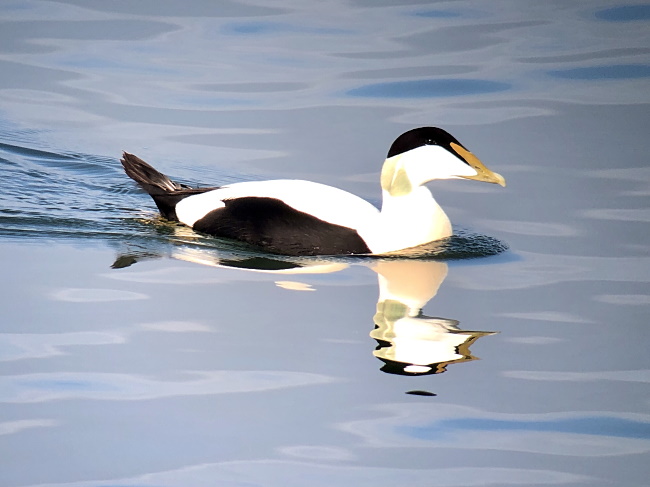
Many thanks go to David Haigh, Colin Schofield, Carole Killikelly, Steve Hinde, David Leeming, Alan Hitchmough, Derek Bates, Allan Conlin, Steve Williams, Karen Leeming, Richard Whitby, Tim Kinch, Frank Burns, Mark Peers, Charles Farnell, David Thompson, David Bradshaw, David Small, Linda Platt, Mark Woodhead, Jeremy Bradshaw, Richard Speechley, Graham Connolly, Steve Hart, Gary Powell, Ron Brumby, Ian Goldstraw, Mark Gibson, Peter Sutton, Stuart Maddocks, Danny Carmichael, Andrew Ingham, Steve Andrews, John Hewitt, Les Hall, Mark Evans, Roy Wilson, Andrew Morriss, Paul Mason,Graham Jones, Eddie Williams, Steven Edwards, Paul Bennett, Huw Morgan, David Roe, Dave Edwards, Chris Wilding, Ken Davies, Sue Crawford, Geoff Robinson, Ed Murphy, David Huntingford, Steve Hasell, Mike Hart, Henry Cook, Bill Owens, Graham Thompson, James Smith, Rob Bodels, David Lea, Stephen Wende, Michael Bewley, Andrew Morris, Ron Armstrong, Pete Chester, Liz Shand, Paul Carter, the Lighthouse and Wirral Birding Blog, the Dee Estuary Wardens and the Hilbre Bird Observatory for their sightings during March. All sightings are gratefully received.
